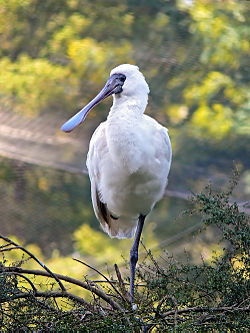Threskiornithidae
| Threskiornithidae | ||||||||||
|---|---|---|---|---|---|---|---|---|---|---|
 Royal Spoonbill
|
||||||||||
| Scientific classification | ||||||||||
|
||||||||||
| Subfamilies | ||||||||||
|
The family Threskiornithidae includes 36 species of large terrestrial and wading birds, falling into two subfamilies, the ibises and the spoonbills. It was formerly known as Plataleidae. The spoonbills and ibises were once thought to be related to other groups of long-legged wading birds in the order Ciconiiformes, including the storks, the herons, and the bitterns. But recent study suggest that they belong to the Pelecaniformes. Whether the two subfamilies are reciprocally monophyletic is an open question. The South American Checklist Committee's entry for the Threskiornithidae includes the following comment "Two subfamilies are traditionally (e.g., Matheu & del Hoyo 1992) recognized: Threskiornithinae for ibises and Plataleinae for spoonbills; because the main distinction has to do with bill shape, additional information, especially genetic, is required to recognize a major, deep split in the family." ([1])
Description and ecology
Members of the family have long, broad wings with 11 primary feathers and about 20 secondaries. They are strong fliers and, rather surprisingly, given their size and weight, very capable soarers. The body tends to be elongated, the neck more so, with rather long legs. The bill is also long, decurved in the case of the ibises, straight and distinctively flattened in the spoonbills. They are large birds, but mid-sized by the standards of their order, ranging from the Dwarf Olive Ibis (Bostrychia bocagei), at 45 cm (18 in) and 450 g (1 lb), to the Giant Ibis (Thaumatibis gigantea), at 100 cm (40 in) and 4.2 kg (9.2 lb).
They are distributed almost worldwide, being found near almost any area of standing or slow-flowing fresh or brackish water. Ibises are also found in drier areas, including city rubbish tips. All are diurnal; spending the day feeding on a wide range of invertebrates and small vertebrates: ibises by probing in soft earth or mud, spoonbills by swinging the bill from side to side in shallow water. At night, they roost in trees near water. They are gregarious, feeding, roosting, and flying together, often in formation.
Nesting is colonial in ibises, more often in small groups or singly in spoonbills, nearly always in trees overhanging water, but sometimes on islands or small islands in swamps. Generally, the female builds a large structure out of reeds and sticks brought by the male. Typical clutch size is 2 to 5; hatching is asynchronic. Both sexes incubate in shifts, and after hatching feed the young by partial regurgitation. Two or three weeks after hatching, the young no longer need to be brooded continuously and may leave the nest, often forming creches but returning to be fed by the parents.
Species
FAMILY: THRESKIORNITHIDAE
- Subfamily: Threskiornithinae - Ibises
- Genus Threskiornis
- Sacred Ibis, Threskiornis aethiopicus
- Madagascar Sacred Ibis, Threskiornis bernieri
- Réunion Sacred Ibis, Threskiornis solitarius extinct
- Black-headed Ibis, Threskiornis melanocephalus
- Australian White Ibis, Threskiornis molucca
- Straw-necked Ibis, Threskiornis spinicollis
- Genus Pseudibis
- Indian Black Ibis, Pseudibis papillosa
- White-shouldered Ibis, Pseudibis davisoni
- Genus Thaumatibis
- Giant Ibis, Thaumatibis gigantea
- Genus Geronticus
- Northern Bald Ibis, Geronticus eremita
- Southern Bald Ibis, Geronticus calvus
- Genus Nipponia
- Japanese Crested Ibis, Nipponia nippon
- Genus Bostrychia
- Olive Ibis, Bostrychia olivacea
- Dwarf Olive Ibis, Bostrychia bocagei
- Spot-breasted Ibis, Bostrychia rara
- Hadada Ibis, Bostrychia hagedash
- Wattled Ibis, Bostrychia carunculata
- Genus Theristicus
- Plumbeous Ibis, Theristicus caerulescens
- Buff-necked Ibis, Theristicus caudatus
- Black-faced Ibis, Theristicus melanopis
- Genus Cercibis
- Sharp-tailed Ibis, Cercibis oxycerca
- Genus Mesembrinibis
- Green Ibis, Mesembrinibis cayennensis
- Genus Phimosus
- Whispering Ibis, Phimosus infuscatus
- Genus Eudocimus
- American White Ibis, Eudocimus albus
- Scarlet Ibis, Eudocimus ruber
- Genus Plegadis
- Glossy Ibis, Plegadis falcinellus
- White-faced Ibis, Plegadis chihi
- Puna Ibis, Plegadis ridgwayi
- Genus Lophotibis
- Madagascar Crested Ibis, Lophotibis cristata
- Genus Threskiornis
- Subfamily: Plateinae - Spoonbills
- Genus Platalea
- Common Spoonbill, Platalea leucorodia'
- Black-faced Spoonbill, Platalea minor
- African Spoonbill, Platalea alba
- Royal Spoonbill, Platalea regia
- Yellow-billed Spoonbill, Platalea flavipes
- Roseate Spoonbill, Platalea ajaja
- Genus Platalea
External links
- Threskiornithidae videos on the Internet Bird Collection